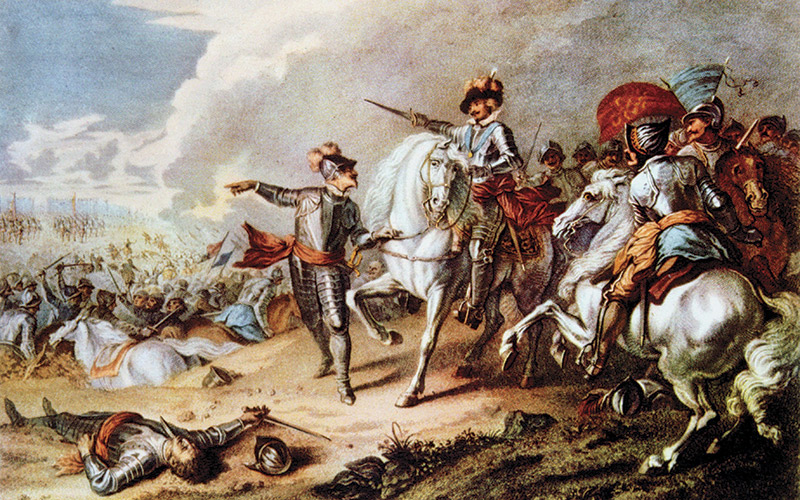With diseases and accidents estimated to have taken more lives than combat in the English Civil War, Stephen Mortlock looks back at this death-stricken period of history.

The English Civil War (1642-1651) stemmed from conflict between Charles I and Parliament. The king believed in his divine right to govern without interference from Parliament, and it was this conceit and arrogance that would eventually lead to his execution. In 1642, after an abortive attempt to arrest five of his biggest critics on charges of treason, even Charles realised that things had broken down between the crown and Parliament. A week later, he left London for Oxford to raise an army to fight Parliament for control of England. A civil war was inevitable.
After the first, indecisive battle of Edgehill in 1642, Oliver Cromwell felt that a professional army would be more successful against the king, and the “New Model Army”, which would become a military unit that transformed the subsequent battles, was formed.
Of course, raising and maintaining an army was not without problems; for almost all of human history, apart from the obvious dangers of warfare, the biggest toll of human life in war was taken by infectious diseases. During the conflict, historians believe that some 180,000 people died, but only 85,000 from combat – the rest were due to accidents and disease. So, although the actual death toll on the field might have been low, without modern medical care it was very easy for wounds that were received in the course of a battle to become infected, leading to blood poisoning and gangrene, which must have been a horrible way to die without antibiotics, anaesthetics or painkillers.
Some examples include Lt-Colonel Johnson of the Basing House garrison in Hampshire “shot in the shoulder whereby contracting a fever, he died a fortnight after”; Lt-Colonel Anthony Fane, a dragoon commander at the storming of Farnham Castle in Surrey “shot through the cheek(s), whereof he died a few days later”. The cause of the fatalities was probably the result of fragments of dirty cloth being driven deep into a wound, either beyond the reach of the surgeons’ instruments or, more likely, being left there to fester.
Richard Wiseman (1621-1676), a prominent physician during the conflict and sergeant-surgeon to King Charles II after the war, best remembered for his book called Severall Chirurgicall Treatises, reintroduced cautery for wounds and recommended that gunshot wounds be bandaged with raw onions to counteract the effects of the gunpowder. He kept an account of a surgery performed after the battle of Weymouth in 1645: “A great Haemorrage happening to a Souldier at the Surprize of Weymouth by the Garrison of Portland, by a shot through the Heel, I endeavoured the stopping the bloud by Astringents, Bandages etc. But after all, I was put to the use of the actuall Cautery; which I did apply successfully.” You might survive the battle, but the peace afterwards could be a real killer.
Camp life and training
In truth, thanks to poor supplies and little in the way of logistics, you were lucky if you got to the battlefield in the first place; the cramped conditions and lack of personal hygiene of the camps were a breeding ground for dysentery or cholera, scarlet fever, typhoid, plague, or diseases transmitted from person to person via lice (or even venereal diseases for the less-than-righteous soldier). Certainly, the name “camp fever” is synonymous with typhus, and arose from the affinity of the disease for these type of conditions. Life in an army camp during training was not easy.
Another problem, peculiar to the marshy, waterlogged fens and to lowland areas of Somerset, Kent and Essex, was that of malaria. Well-documented examples are difficult to come by, although frequent references to “ague” or recurrent fever are highly suggestive of malaria. Certainly Cromwell, himself a “fenman”, showed evidence of having this infection for most of his life and it was probably the cause of his death. References to quartan fevers in the 17th and 18th centuries suggest that this was caused by P malariae. Thomas Sydenham (1624–89), a leading 17th century English physician, wrote in Observationes Medicae in 1676 that “anyone dwelling in the locality of marshes and lakes became impressed with a certain miasma which produces a quartan ague”.
Another contributory factor would have been the uncertain nature of the daily diet and the vagaries of the weather. Accounts from soldiers in Holles’ Regiment of Foot (a Parliamentarian regiment that was recruited predominantly from London apprentices serving in the butchering and dyeing trades) describe how in the summer months, for lack of other sustenance, the marching troops “drank stinking water”, sometimes scooping it from the shallow indentations left by horse hooves! The soldiers were regularly soaked to the skin, and unable to dry their clothing adequately which would become filthy and often infested with lice – soldiers noted that when stripping the corpse of a Royalist drummer they found it to be “very lowsey”. As a result of this, wounds frequently became infected, often with fatal consequences.
The privations endured during the winter months must have also produced a considerable number of cases of sickness, due to the extremes of cold, continual exposure to wet clothing and footwear, and the debilitating effects of an inadequate diet. Pneumonia and bronchitis must have been an ever-present hazard, while tuberculosis would have exacted an annual toll of deaths. The low resistance to infection engendered by the poor diet, incipient vitamin deficiencies – especially scurvy – and the climatic rigours to which troops were exposed compounded this problem.
Besieged towns
Civilians also suffered the ravages of the conflicts. Royalists and Parliamentarians were constantly trying to impress men into their armies. Both sides took horses, food and other supplies for their armies. They forced people to provide free food and shelter to whichever troops turned up in their farm, village or town. In desperation, some areas formed their own militia to keep the Royalists and Parliamentarians away from their homes. There were severe outbreaks of plague in a number of towns and cities in England and Wales, especially during 1644 and, to a lesser extent, 1645.
Of course, plague had existed in England as an endemic disease for about 400 years, enlivened by periodic epidemics and occasional spectacular pandemic, the best known of which is the Great Plague of London in 1666. Outbreaks also occurred if the rat fleas (Xenopsylla cheopis) were transported in bales of woollen and other cloths from one town to another. This mode of transmission accounted for the characteristic sudden and sporadic outbreaks of plague in apparently unconnected locations. But generally, the largely open nature of the civil wars, with relatively few prolonged sieges, mitigated against plague as a major threat to troops who could, if they were aware of the presence of the disease in a town, avoid it.
Person-to-person infection with typhus, however, was a different matter entirely. The pattern and symptoms of the fever that decimated the Earl of Essex’s Army at Reading in 1643, suggests typhus. Likewise, Sir William Waller's successful siege of Chichester in early 1644 was also followed by an outbreak of typhus amongst the garrison. Other serious outbreaks in 1644 occurred in several towns in the west country, particularly Tiverton in Devon, which was occupied for periods of time by Royalist and Parliamentarian armies in turn.
Other important “siege diseases” were smallpox and measles. The garrison of Basing House in Hampshire suffered from an outbreak of the former in 1644 at the height of the 19-week long siege. It should be remembered that the species of smallpox prevalent in England at this time was the milder European version known as alastrim (Variola minor), and not the more virulent Asiatic form which replaced it. Otherwise, the siege of Basing House would have ended abruptly with the death of most of the besieged. Similar outbreaks of a disease that disfigured rather than dealt death occurred in the Oxford garrisons during 1644, and no doubt among many other unrecorded towns and villages as well.
Conclusions
Death and incapacity due to illness, whether infectious or caused by diet and climatic conditions, may have played an important role in deciding some of the military outcomes of Civil War engagements. It clearly affected the fighting capacity of many soldiers, particularly unacclimatised town-dwellers, such as the London Trained Bands, who were quite unused to the rigours of the frequently unfriendly English climate.
It is estimated that England suffered a 3.7% loss of population and Scotland a loss of 6%, while Ireland suffered a loss of 41% of its population. This is in contrast to the 3% of the British population that died in the First World War.
The impact on communities was devastating: homes were destroyed, the men needed for farming were gone and disease was rampant. Families were torn apart: brother against brother, son against father.
Moreover, there was the trial and execution of an anointed sovereign, and the presence of a standing army throughout the 1650s – the success of the New Model Army having demonstrated the benefits of a national standing army, rather than one with regional allegiances. After the restoration, Charles II created a standing army that was the forerunner of the modern British army.
Stephen Mortlock is Pathology Manager at Nuffield Health, Guildford Hospital.




